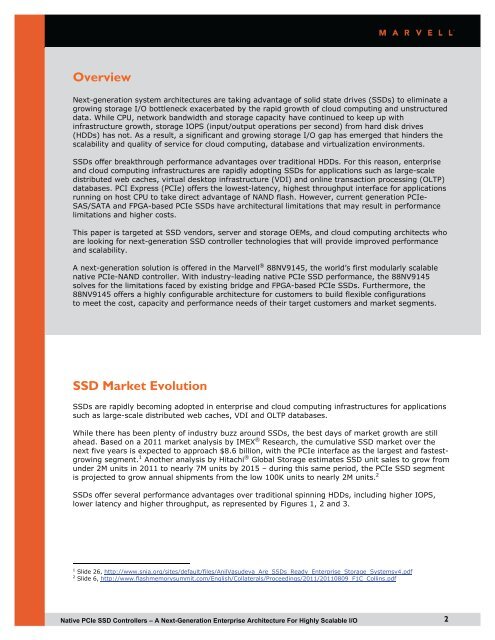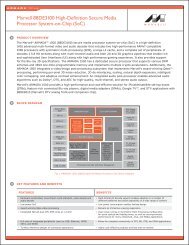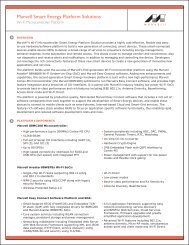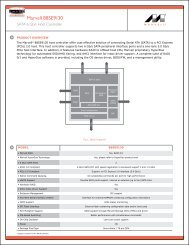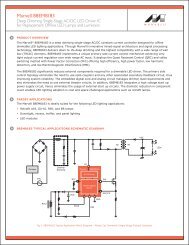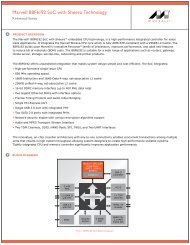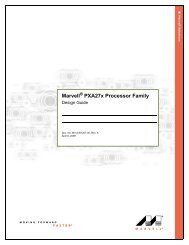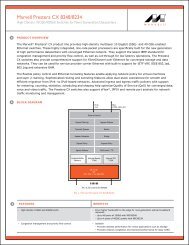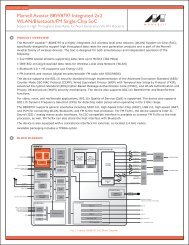Native PCIe SSD Controllers
Native PCIe SSD Controllers - Marvell
Native PCIe SSD Controllers - Marvell
Create successful ePaper yourself
Turn your PDF publications into a flip-book with our unique Google optimized e-Paper software.
Overview<br />
Next-generation system architectures are taking advantage of solid state drives (<strong>SSD</strong>s) to eliminate a<br />
growing storage I/O bottleneck exacerbated by the rapid growth of cloud computing and unstructured<br />
data. While CPU, network bandwidth and storage capacity have continued to keep up with<br />
infrastructure growth, storage IOPS (input/output operations per second) from hard disk drives<br />
(HDDs) has not. As a result, a significant and growing storage I/O gap has emerged that hinders the<br />
scalability and quality of service for cloud computing, database and virtualization environments.<br />
<strong>SSD</strong>s offer breakthrough performance advantages over traditional HDDs. For this reason, enterprise<br />
and cloud computing infrastructures are rapidly adopting <strong>SSD</strong>s for applications such as large-scale<br />
distributed web caches, virtual desktop infrastructure (VDI) and online transaction processing (OLTP)<br />
databases. PCI Express (<strong>PCIe</strong>) offers the lowest-latency, highest throughput interface for applications<br />
running on host CPU to take direct advantage of NAND flash. However, current generation <strong>PCIe</strong>-<br />
SAS/SATA and FPGA-based <strong>PCIe</strong> <strong>SSD</strong>s have architectural limitations that may result in performance<br />
limitations and higher costs.<br />
This paper is targeted at <strong>SSD</strong> vendors, server and storage OEMs, and cloud computing architects who<br />
are looking for next-generation <strong>SSD</strong> controller technologies that will provide improved performance<br />
and scalability.<br />
A next-generation solution is offered in the Marvell ® 88NV9145, the world’s first modularly scalable<br />
native <strong>PCIe</strong>-NAND controller. With industry-leading native <strong>PCIe</strong> <strong>SSD</strong> performance, the 88NV9145<br />
solves for the limitations faced by existing bridge and FPGA-based <strong>PCIe</strong> <strong>SSD</strong>s. Furthermore, the<br />
88NV9145 offers a highly configurable architecture for customers to build flexible configurations<br />
to meet the cost, capacity and performance needs of their target customers and market segments.<br />
<strong>SSD</strong> Market Evolution<br />
<strong>SSD</strong>s are rapidly becoming adopted in enterprise and cloud computing infrastructures for applications<br />
such as large-scale distributed web caches, VDI and OLTP databases.<br />
While there has been plenty of industry buzz around <strong>SSD</strong>s, the best days of market growth are still<br />
ahead. Based on a 2011 market analysis by IMEX ® Research, the cumulative <strong>SSD</strong> market over the<br />
next five years is expected to approach $8.6 billion, with the <strong>PCIe</strong> interface as the largest and fastestgrowing<br />
segment. 1 Another analysis by Hitachi ® Global Storage estimates <strong>SSD</strong> unit sales to grow from<br />
under 2M units in 2011 to nearly 7M units by 2015 – during this same period, the <strong>PCIe</strong> <strong>SSD</strong> segment<br />
is projected to grow annual shipments from the low 100K units to nearly 2M units. 2<br />
<strong>SSD</strong>s offer several performance advantages over traditional spinning HDDs, including higher IOPS,<br />
lower latency and higher throughput, as represented by Figures 1, 2 and 3.<br />
1 Slide 26, http://www.snia.org/sites/default/files/AnilVasudeva_Are_<strong>SSD</strong>s_Ready_Enterprise_Storage_Systemsv4.pdf<br />
2 Slide 6, http://www.flashmemorysummit.com/English/Collaterals/Proceedings/2011/20110809_F1C_Collins.pdf<br />
<strong>Native</strong> <strong>PCIe</strong> <strong>SSD</strong> <strong>Controllers</strong> – A Next-Generation Enterprise Architecture For Highly Scalable I/O<br />
2


